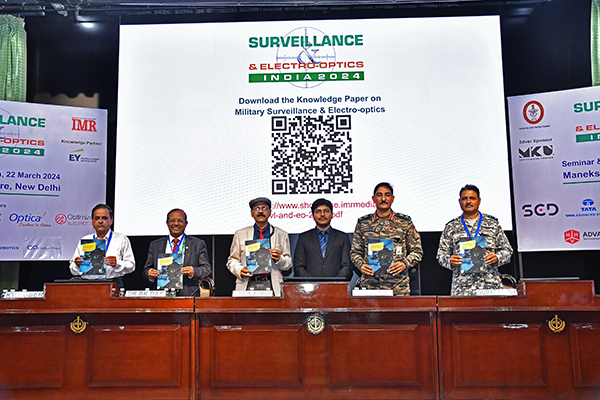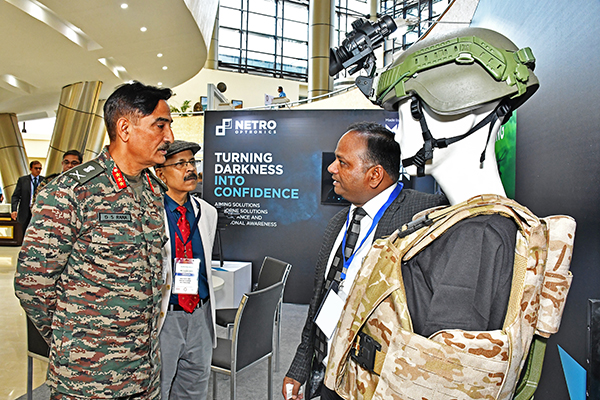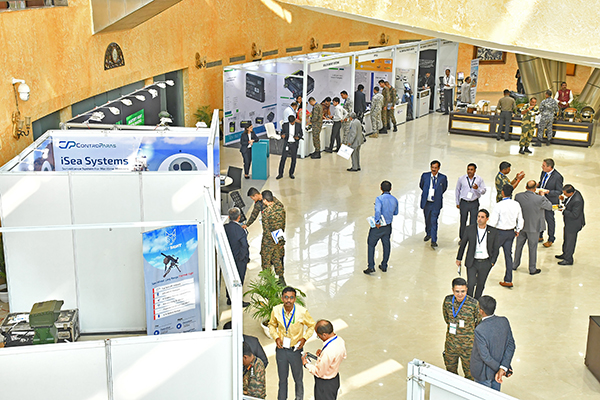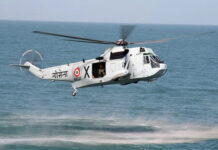
The Centre for Joint Warfare Studies (CENJOWS and Indian Military Review, organized Surveillance & Electro Optics India 2024 seminar and exhibition on 22 March 2024 at the Manekshaw Centre, New Delhi. The seminar offered a platform for the industry to interact with the armed forces to understand their Surveillance & Electro Optics requirements, business prospects, trends and latest developments.
Session 1: Inaugural Session
Maj Gen (Dr) Ashok Kumar, Director General CENJOWS, said that the deliverables are not fully visible in the Services as far as Surveillance & Electro Optics are concerned. Much more needs to be done. He further enumerated that the Surveillance & Electro Optics systems consist of one of the four components essential for warfighting and these are:
• Sensors -They are the eyes and ears that sense the situation in the air, land, and sea domain.
• Data and communication links through which sensor outputs are transmitted to the systems where it will be stored, analyzed, and acted upon.
• Command and Control Centre/ Data Fusion Centre, where the data will be processed and decisions are taken to respond.
• Shooter – is the final component which will react to the emerging situation.
The sensor is the most critical element of the loop, so surveillance using electro-optical sensors is the most important part of the chain. We need to investigate the spectrum and bandwidth the systems need to work upon efficiently. The systems must have the capacity to connect and work together with the three services, and the compatibility with the existing systems will improve their capabilities.
Lt Gen DS Rana, Director General Defence Intelligence Agency delivered the inaugural address stating that, electro-optical sensors harvest the capabilities of optics and electronics to analyze high-resolution visual images in real time. The current conflicts in Ukraine, the Red Sea situation, the South China Sea, the nuclear ambitions of Iran and firings by North Korea are driving the world into an unstable situation. In our neighbourhood, Pakistan is facing an economic crisis, and China, too, is increasing its footprints not only on land but at sea. The need for high-grade sensors onboard drones and space-based assets is proliferating. The role of commercial intelligence data by Maxar has helped Ukraine analyze the movement of Russian troops and counter the threat in time before the attack began. Ukraine has access to NATO-based intelligence, and Russia and Ukraine are continuously attacking the targets in depth using PNT. China has increased its space-based capabilities with EO imaging revisit of about fifteen minutes, two hours in SAR, near-continuous coverage of ELINT in the Indian region. It has ISR capabilities in geosynchronous orbit for round-the-clock coverage in the Pacific and Indian Oceans. China is developing a ground-based system in Pakistan that will enhance BeiDou accuracy to 15cm based on PNT to enhance its regional precision strike capabilities. The unmanned drones can conduct ISRs and are equipped with high-definition IR and SAR sensors. Pakistan is building up its capabilities for coverage of its land borders along Iran, India and Afghanistan using high-definition EO sensors fitted drones. HAPS are solar-powered drones that fly above 20 km for persistent capabilities for many months with a resolution of 15cm. Ground-based sensors can sense the movement of troops using acoustic sensors, and China has operationalized an EO grid along the Line of Actual Control for all weather coverage. The maritime role relies on various sensors, such as long-range patrol aircraft and acoustic sensors fitted on undersea autonomous vehicles. All these developments in the sensors onboard space, air and sea-based platforms have resulted in a paradigm shift in how intelligence is gathered. There is no shortage of data, and the use of data analytics and machine learning algorithms using AI will only help in analyzing the spatial data from a variety of sensors. The use of GIS for the fusion and visualization of spatial data is a growing field many intelligence agencies have adopted. The growth of MASINT (measurement and signature intelligence) is where data from multiple sensors capable of sensing data like electromagnetic, electro-optical, acoustic, and chemical composition are fused. Only the US and Israelis have this technology and our efforts to shore up this technology is the need of the hour. The next challenge is to fuse the data and generate the information using network nodes. These data can be shared in a secure grid to seamlessly counter emerging threats in various domains. He concluded by mentioning that the current global conflicts and geopolitical situations are driving the need for high-grade sensors onboard drones and space-based assets. Both China & Pakistan are developing space-based capabilities, including imaging and coverage in the Indian region. Further, the use of data analytics, machine learning algorithms, and GIS for spatial data fusion and visualization is becoming increasingly important. The growth of MASINT technology, which combines data from multiple sensors, is a priority for many intelligence agencies. The next challenge is to effectively fuse and share data to counter emerging threats.
The Keynote Address was delivered by Air Marshal Surat Singh, Director General Air Ops, Air HQ. He defined the emerging warfighting using the sensors in the following roles:
• Superior Battlefield transparency.
• Networking of all sensors.
• Shortening of OODA loop using automated data support loop.
• Swift response using agile weapons.
They are being done at the HQ level to enable the standardized operation of data formats, protocols, and interfaces. The aerospace domain requires the exploitation of space, air and surface-based sensors. The commercialization of space and dual-use technology must be used optimally. In addition, identifying threats in space, air surface and maritime has to be done almost on a real-time basis using private and public assets. The requirements for space-based solutions that the Air Force has met, are, Stratospheric and persistent platforms assets, Low-cost and fast deployable and expendable assets, Interface with the existing networks like the IACCS system. It enhances the space segment and sensors’ networking to provide sufficient early warning and intercept opportunities. He concluded by discussing the use of sensors in emerging warfighting strategies. These must be implemented for achieving superior battlefield transparency, shortening the OODA loop, integrating all sensors, through automated data support. The air and space domain requires the optimal use of space, air, and surface-based sensors, commercialization of space and dual-use technology. Real-time threat identification in various domains is crucial and can be achieved using both private and public assets. He concluded that the Air Force has successfully met the requirements for space-based solutions, including stratospheric and persistent platforms, low-cost and fast deployable assets, and interface with existing networks.
A Special Address was delivered by Dr BK Das, DG Electronics and Communication Systems (ECS), DRDO. He highlighted that DRDO was working on a comprehensive approach to monitoring warfare trends, both in the outer space and undersea domains. It will be a non-contact war with autonomous weapons with robotics and cyber playing an important role. The next engagement is characterized as zero physical touch, as it will involve use of autonomous weaponry, AI based robots and cyber warfare. Technology wars would require careful re-alignment between country’s tech capabilities, weapon manufacturing, and industrial infrastructure to sustain them. Prioritizing development and maintenance of technological edge is crucial to come out of reliance on the other countries. DRDO is deliberating various options for services, to include SAR and LIDAR technology, advanced radar technologies, and the concept of a “Digital Soldier as a System.” The Services will utilize AI-based electro-optic soldier, autonomous decision-making abilities, robotics capabilities, and its ability to network. Cognitive Warfare is using advanced technologies to disrupt or manipulate adversary’s cognitive processes, while first-person drones will be resistant to EI & RF Interference. He further spoke about how Quantum computing will be used for surveillance in multi-domain battlefields which will facilitate object detection and identification through data gathering, fusion, and analysis. In conclusion, he re-iterated that the DRDO is working towards a comprehensive approach to monitoring warfare, incorporating technologies like artificial intelligence, space warfare capabilities, nanotechnology, big data, and additive manufacturing.
Col K V Kuber, Director Defence & Aerospace, Ernst & Young gave the industry perspective. He said that interoperability was the key for a functional surveillance system with impunity. Indian industries must collaborate with global vendors to get competitive. To reduce Indian dependence on foreign countries, we have to pep up our industrial base and ecosystem. Investment in the indigenous industry is essential to reduce India’s reliance on resources of the other countries. Strategic partnerships are the key. AI will be applied in almost all domains for crucial inputs on data. Sensors in all domains will be used to boost situational awareness and manage information overload. He concluded by re-iterating that data is crucial for intuitive design and industry must develop advance technology in sensors globally. We must ensure that India should be fully prepared indigenously for potential confrontations and early use of weapon systems based on sensors in all domains.
Session 2: Terrestrial Surveillance
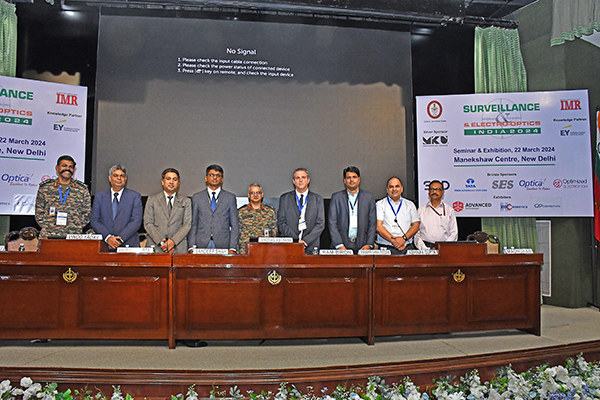
The session was chaired by Brig Anurag Asthana, Brig Ops, Artillery Directorate, Army HQ. He introduced the session by drawing inferences from present global scenarios and how countries are striving for military development. He referred to the 7 October 2023 attack launched by Hamas on Israel as an example of growing conventional and asymmetric warfare equipped with lethal weapons. Touching on the session theme ‘Terrestrial Surveillance’, he reiterated the significance of multi-sensors and how the Indian Army was continuously working to upgrade surveillance facilities. He said that future battlefields would be driven by miniaturized Unmanned Autonomous Systems (UAS) and Artificial Intelligence (AI), highlighting how AI was being used for reading huge data and had opened “new vistas.” He flagged the requirement of surveillance through deployment of sensors that would allow sufficient time to process data. Passive surveillance would remain beneficial than active surveillance and that the surveillance grid needs to have full proof communication systems.
Shri Madhukar DIG (Ops) Force HQ BSF covered the challenges being faced by the Border Security Force in managing the borders at night. His presentation showcased an overview of the responsibilities of the BSF, present facilities related to surveillance and future challenges that requires to be addressed. Stressing on the dynamic terrain and climate of the Indian subcontinent, the speaker elucidated on the peace time and wartime responsibilities undertaken by the BSF for each of the geographical commands. The Western Sector revolves around the increased use of UAVs, tunnelling across international borders, low visibility during winters, poorly lit areas and non- effectiveness of Surveillance equipment during winters. Similarly, the challenges in the Eastern Sector are specific to altitude and temperature. The BSF has incubated several responses that include Hot Interception Team, Naka cum Ambush, Foot patrolling, Anti-drone operations and even Boat Naka. He further highlighted several projects undertaken by the BSF and comprise of ‘Comprehensive Integrated Border Management Systems’ (CIBMS), ‘Electronic Surveillance of vulnerable patches’ (ESVP) and OCTS project. In the concluding remarks he reiterated continued collaborative measures between BSF with DRDO, IITs and agencies like NTRO for technical solutions with integrated security system at borders. Additionally, the introduction of smart fences will be a game changer with high tech surveillance devices such as sensors, ground-based radar systems, etc, to provide a holistic surveillance mechanism.
Col Sameer Babu, Colonel (C&R), Army AD Directorate, Army HQ, spoke on the Latest Developments in Tackling Threats and C&R for Air Defence, emphasized that Army AD was the largest user of radars amongst the three Services. He touched upon the threats emanating from various altitudes and speeds which call for a dynamic surveillance system in addition to the existing ones. He also highlighted the evolving air threat and the growing impact of air power with the need for an effective air defence capability for land operations. Advancements in radar technology was flagged. Development of passive radar technology will remain a game changer since it is highly cost-effective and compliments existing radar systems. Multiple Inputs, Multiple Output (MIMO) radar technology that has evolved from communications systems provides an edge by simultaneously radiating uncorrelated signals, improving coverage and signal quality. He also flagged the use of ‘Digital Beam’ technology that can be deployed to achieve higher angular resolution and wide coverage without mechanical moving parts. The usage of ‘Active Electronically Steered Array Radar’ and ‘Radar Digital Signal Processing’ were also discussed.
The session also saw participation by several industry players and start-ups who making strides in surveillance and electro-optics equipment.
Vaibhav Gupta, Director, MKU Ltd, spoke on Electro-Optics: Shaping Modern Warfare & Defense Strategies – Learnings, Lessons & Implication In 2024. He spoke on how electro-optics was shaping warfare and defence strategies by drawing lessons from contemporary conflicts, which revealed larger and recurring requirement of equipment and night vision devices, enhanced role of sensor-based technologies, and the need for efficient solutions which deliver “first salvo effectiveness.” This meant there was a need to be self sufficient in manufacturing and core technologies. He then presented MKU’s Smart Soldier Solutions (Netro Soldier Optronics and Kavro Soldier Protection) and Smart Platform Solutions (Netro Platform Optronics and Kavro Platform Protection).He also gave details of MKU’s facilities and reach of its products and clients around the world.
Ram Biron, Director of Marketing, SCD, Israel, spoke on Advanced integrated applications utilizing high definition format IR detectors. He gave details about SCD’s credentials, facilities, core technologies in infrared detectors and video engines. He explained SCD’s share of cooled 2nd-gen scanning and staring FPAs, InGaAs FPAs detectors and modules in the defence market. He covered key global trends in IR sensors which were driving SCD’s road map. His presentation included SCD’s cooled detectors and video engines (MW/LW), new-gen SWIR solutions, combined HD MWIR and 3rd-gen ALPD SWIR, and next-gen DAS for armoured fighting vehicles.
Sandeep Shah, Managing Director, Optimized Electrotech, spoke on Assisted & Automated Surveillance. He gave details about the company and progress, patents, certifications, and clients. He cited challenges in surveillance – border conflicts, undemarcated borders, infiltration, and specific geopolitical and geographical challenges in India. He gave details about Optimized Electrotech products – NoctVision, InfiVision, ClearVision, and OmniVision. He also gave details and benefits of Autonomous AI based multi-spectral surveillance platforms.
Abhinav Gupta, Managing Director, SES, spoke on Rechargeable Li-Ion Batteries for Military Devices. He gave an overview of his company, products, present challenges in battery use, indigenous solutions, capabilities and in-house facilities. SES has worked for Indian and Israeli armed forces. SES solutions included smart chips and intelligent programming, intelligent electronics, advanced machining, novel materials and innovations.
Vinod Yadav, Head-Technical (Optronics & Computing Platforms), Tata Advanced Systems Ltd spoke on Products and Solutions in Electro-optics. He gave details about Tata Advanced Systems’ business verticals, product portfolio (Weapons, Sensors, C4I systems), and particularly the portfolio in electro-optics (cooled TI systems, uncooled TI systems, II-tube based NVDs). He gave details about short-range observation systems, long range observation systems (Rajak ULR), modular long range surveillance platforms, weapons sights, crew vision systems. He also spelt out TASL’s future technology focus areas.
Ramkrishna Siddam, General Manager, Optica spoke on Complete Solutions for Next-Generation Electro-Optical Systems. He overview of his company, capabilities, certifications, products, core expertise, testing facilities, and optics & electro-optical systems including Schlieren Systems, optics for TMT, Aerosol LIDAR, Cloud LIDAR, MIR LIDAR, FTIR System, Adoptive Optics BDOC System, Light Weight High Power Laser Mirror, IR panoramic camera and ongoing projects including Surya Tilak project for Ram Mandir at Ayodhya.
Session 3: Aerial In Space-based Surveillance

The session was chaired by AVM Rajiva Ranjan, ACAS Ops (Space), Air HQ. He said that military intelligence was the key to war. Space and air are the ultimate frontiers. In 1991, Space ISR became prominent. Aerial and SAR systems are very vital assets for military in multi-domain operations. Aerial SAR, integrated on aircraft, offers various advantage of fast deployment and flexibility, enabling real-time monitoring and target identification in various terrain and all domains. These systems provide crucial intelligence for mission planning, threat assessment, and battlefield situational awareness. On the other hand, SAR satellites provide persistent surveillance capabilities to monitor vast areas continuously for global coverage. They offer high-resolution capabilities that detect and track moving targets and assess changes in the environment. Both aerial and space-based SAR systems were integral components of military reconnaissance in providing invaluable support for operations, intelligence and decision-making processes in all domain.
Col Jasbir Mann, Col Aviation-10, Army Aviation Directorate spoke on UAV sensor payloads for persistent surveillance, and emphazied on the technologies for future warfare which could include three main types of technologies – Foundational, Strategic and Tactical. Examples included Artificial Intelligence, space technology and cyberwarfare. There is also a list of other advanced technologies like nanotechnology and robotics. He mentioning the need of all-weather aircraft and surveillance systems with capability of contemporary payload with high resolution.
Wg Cdr Aruna Singh, DIPAC, Def Space Agency spoke on Space-based ISR for early warning. Space Surveillance along with Military operations rely heavily on surveillance and reconnaissance, to perform strategic and tactical imaging over areas of interest with persistent surveillance. Geosynchronous satellites offer wider surveillance over wide areas particularly denied by other surveillance devices. The speaker highlighted the significance of gathering intelligence to effectively plan and carry out military operations, making well- informed decisions. She discussed the importance of adjusting military forces in response to shifts in an adversary’s order of battle (ORBAT) and making necessary revisions to future actions. Regarding EW satellites, she mentioned that they are designed to specifically detect ballistic missile launches. It was later incorporated into missile defence systems and regulatory control systems for nuclear tests as these satellites have the capability to detect a missile launch right from the start of its trajectory. They utilize infrared sensors to detect missile engines based on the intense heat emitted by their flames. They possess a distinct advantage over radar in their ability to scan a significantly larger area. As on date, three nations-USA, Russia, and China possess constellations of these early warning satellites. Lastly, she emphasized the advantages of the Space-Based Infrared System (SBIRS). This system consists of a network of satellites in geosynchronous Earth orbit and payloads in highly elliptical orbit, all managed by ground processing and control systems. These systems are held by three countries only so far.
Air Cmde Hrushikesh J Page, Air Cmde Int (Ops), Air HQ spoke on Latest developments and requirements for Tactical Recce (EO, SAR, IR Search). Having a deep understanding of tactical reconnaissance is crucial for successful military operations. It allows for thorough analysis of the ever-changing dynamics of the battlefield, accurate identification and prioritization of targets, efficient management of information dissemination, and effective communication. It is of utmost importance in dangerous environments such as nuclear, biological, and chemical. The equipment needs to possess a high level of agility, resilience, efficiency, and seamless integration with systems. Utilizing cutting-edge technology, such as face and text recognition, is crucial for precise identification. Security and compatibility are of utmost importance. Having equipment such as ELINT, SAR, and IR is crucial.
Dr Manvendra Singh, Scientist G, IRDE, DRDO spoke on Intelligence Gathering with EO Sensors for Today’s Missions.
Session 4: Maritime Surveillance, Research & Development

The session was chaired by Cmde Ashish Bhargava, Cmde Air Warfare & Flight Safety, Naval HQ. He emphasized the importance of maritime surveillance in the Indian context owing to the long coastline. He said that maritime surveillance was an amalgamation of a lot of platforms with sensors with the inherent challenge of transporting the data due to absence of terrestrial network.
Comdt Banshidhar Singh, Joint Dir Communications, Indian Coast Guard spoke on Surveillance against Aerial, Surface and Underwater Threats. He highlighted the importance of surveillance in the maritime domain for ensuring an appropriate response to any developing situation relating to maritime safety and security. He defined the objectives of maritime surveillance to holistically understand, anticipate and administer all events and actions related to the maritime domain that could impact the maritime security. He said that it includes and relies on maritime law enforcement, maritime pollution and marine environment control, disaster response, search and rescue, anti-poaching, anti- smuggling, anti-human trafficking and safeguarding countries’ trade and economic interests. So, the prime objective is to detect any suspicious or anomalous target that could subvert the national interest in the maritime zones. He acknowledged the need to upgrade capabilities by keeping in tune with the advancements in technologies and put forth some recommendations for the ICG which include adaptation of existing magnetron-based radars to solid-state radars, daylight CCD thermal imager with laser illumination, electro-optic system to HD thermal camera, CCD with short wave infrared technology to see through haze, fog, glass, and better ranges, and inclusion of satellite AIS for better coverage.
Cdr K Varun, Cdr AW, Naval HQ spoke on Integrating Assets for Maritime Surveillance. He talked about complexity of maritime surveillance of the IOR because of the amount of maritime traffic that transits this region which is further exacerbated by the thousands of fishing boats and the requirement of keeping an eye on the three domains of surface, sub-surface and air by the Indian Navy. He also mentioned the government’s stance on India being the ‘First Responder & Preferred Security Partner’ and the role being played by the Indian Navy currently in the Gulf of Aden. He spotlighted the importance of Maritime Domain Awareness (MDA) and its centrality to the information, decision and action cycle. He mentioned the various fixed & rotary wing and manned & unmanned platforms and the surveillance sensors in service with IN for building the MDA. He also covered the various surface and sub- surface platforms, sensors and weapons utilized by the IN towards the task. He threw some light on how all this data from the IN’s sensors and from other agencies including space is aggregated, correlated and disseminated by the Information Management and Analysis Centre (IMAC).
Maj Gen (Dr) Ashok Kumar, Director General CENJOWS gave the closing remarks, alluding to the rise of India as a leading economic power and the need for the defence forces to rise to the challenges towards which the three services are willing to state their needs in an open and upfront manner and there is much visible collaboration between the forces and the industry. He said that the defence forces are ready to hand-hold those who are willing to be partners in the growth of the defence forces and the nation.
Maj Gen Ravi Arora, Chief Editor, Indian Military Review, ended the seminar with a vote of thanks to the speakers, subject matter experts, sponsors, exhibitors, all attendees and CENJOWS for the success of the event.




